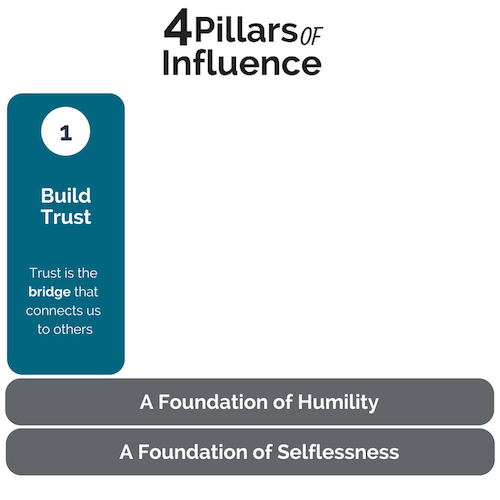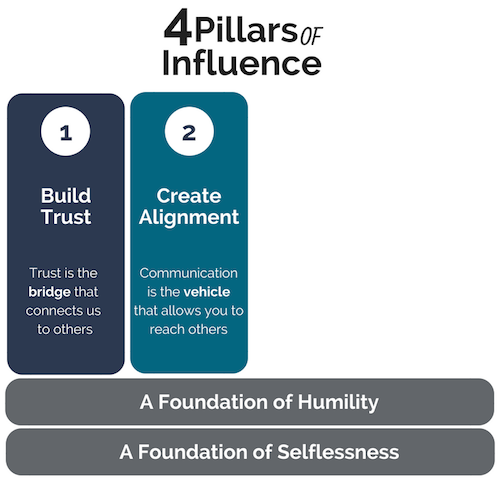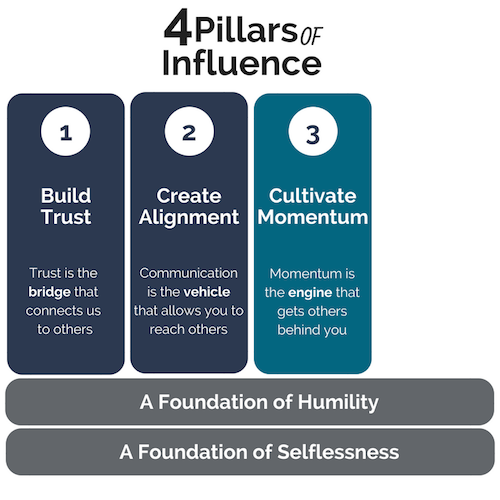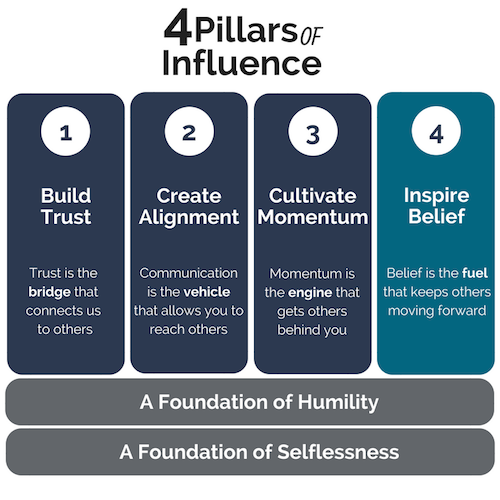How To Lead When You Have No Authority – The Startup – Medium
Four Pillars to Increase Your Influence Both at Work And in Life
Everyone remembers the 2002 movie, My Big Fat Greek Wedding. It’s a hilarious story about the struggles of Toula (the daughter of a traditional Greek family) as she tries to fall in love and get married.
There is one particular scene where Toula asks her father permission to go to college. She makes a rather good case (as you can see below) but her father responds in a dramatic voice “Why do you want to leave me!”.
This leaves no hope for Toula because her father is the head of the house and what he says goes… or so she thought.
That is when Toula’s mother steps in and says “Don’t worry Toula, I will talk to your father” but Tula replies “Mom dad is so stubborn and you know what he says, the man is the head of the house.”
Her mother responds “let me tell you something Toula, the man is the head but he woman is the neck, and she can turn the head anyway she wants.”
This hilarious moment in the movie actually captures some powerful principles. I know the movie is satirical and over-stereotypes the characters, but follow me on this one, I think there are some good points to be made.
First of all, the mother is not proud. She doesn’t need to be the “head of the household” to lead. She recognizes that she can lead through her influence.
Second, the mother is not self-seeking. Her motivation is completely to help her daughter go to college. She is not pursuing her own ambition or interests, but rather the interests of others.
Think of these two concepts as the foundation of everything you read in this article. The article presents four pillars on how to lead without authority, but I warn you, if you try to use these pillars without placing them on this foundation, they will just fall over.
In fact, these pillars cannot be implemented unless they are placed on the foundation of humility and selflessness; however, if you can accept these principles, these pillars will completely transform your ability to lead. You will be empowered to transform just about any situation you find yourself in — whether you are in a position of authority or not.
Leading Without Authority
I was first introduced to the concept of leading without authority back when I worked for a highly dysfunctional organization. I watched as major projects nose-dived into oblivion, everyone swirled in a whirlpool of angst and mistrust, and people always seemed to think that “someone else” was the root of their problems.
This was a tough time for me because I didn’t know how to change my situation.
Sure, If I was in charge I could do something about it, but that wasn’t the case. My boss ran the show and I was powerless… or so I thought.
Someone proposed the concept of leading without authority and it sounded like an oxymoron to me. How could I lead if I wasn’t in charge? Still, something about the concept intrigued me.
I always get a kick out of new ideas and “out-of-the box” thinking, but to my surprise, this idea wasn’t new at all. It was a widely taught practice in leadership circles.
For instance, John Maxwell (a prominent voice on leadership) says:
“Leadership is a choice you make rather than a place you sit. In other words, leadership comes from influence and not from your position. For this reason, even when you’re not in front, you’re still leading those around you.”
Many other prominent leaders have said similar things. For instance Michael Hyatt says:
“Leadership is about influence, not control. I am not the first person to make this observation, but it is worth repeating… Aspiring leaders would do well to stop focusing on control and figure out how to expand their influence..”
That is exactly where I found myself — focusing on things I couldn’t control (like where I sat in the organization) and not on the things I could (like the amount of influence I had). I thought the only way to change my situation was from the top down, but the conventional wisdom on leadership was saying exactly the opposite. It was saying the only way to change my situation was from the bottom up.
It didn’t take long before I realized the wisdom of those words. I mean come on, If all I did was sit around and say “wait until I’m in charge, then you’ll see, it will be different” what good is that?
Don’t sit around and wait for a day that may never come. Instead, choose to start changing your situation right now. You’ll be surprised how far small steps in the right direction will take you. As Lao Tzu famously said:
A journey of a thousand miles begins with a single step.
— Lao Tzu
Four Pillars to Increase Your Influence
This article takes everything I have learned over the past 15 years on the topic of leading through influence and distills it down into four actionable principles (or pillars). I have applied these pillars for a long time and they have empowered me in so many situations.
Early in my career — when I was a front-line worker with no authority — they gave me the ability to influence the direction of my organization.
Today, I use them just as much, even though I have since risen up the ranks and now serve as part of an executive leadership team that charts the strategic course of my organization.
My point is this, there is no fluff or empty words here, these pillars govern human interaction and as such, they are always applicable to your situation. If you have no authority you can use them to lead through influence. Likewise, even if you have authority, you can still use them to lead through influence.
This is because these pillars enable you to win people’s hearts. They inspire other’s to follow you because they want to not because they have to.
This is superior to authority because when people want to follow you they will always give you their best; while, if they only follow you because they have to, they will always give you the bare minimum that they can get away with.

1. Build Trust: Trust Comes First
There is nothing more important than trust. You can have incredible talent, extraordinary credentials, and even say all the “right” things, but if people don’t trust you, they won’t follow you.
Trust is not an action or a resume, it is a feeling that other’s have about you. This feeling comes from two things: 1) a belief that you have their best interests at heart, and 2) a confidence that you have the ability to help them.
Some of the best ways to build this are to ask people for advice and listen to them (everyone wants to be heard), to take a personal interest in what is important to them (this validates them), and to always be genuine (this shows them you have no agenda).
Think of trust as the bridge that connects you with others; with it they will listen to you, but without it, they won’t.
That’s why trust must come first. When you build it with the people around you — whether they are your bosses, peers, or subordinates — this increases your influence within your organization.
That influence is key because it is what gives you the opportunity to lead others in a better direction.
Practical Application:
How I have applied this: I vividly remember one woman (who I will not name) who was overly competitive. She would constantly undermine me and inflate herself in order to get ahead.
She was also in a position of authority over me, albeit she was not my boss.
The problem was that my boss listened to everything she said, and since he was cooped up in his office all day, he had no basis to question it.
This was unjust and really frustrating, but I refused to let her get the best of me. Instead of responding to this situation in the typical way, I decided to take the high ground. After all, I may not have been able to control the situation, but I could certainly control my response.
Here is what I did. I started asking her for advice on projects I was working on.
This flabbergasted her. She literally did not know how to respond to it. One part of her was thinking “what is he up to?” the other part was “of course he needs my advice.”
But I didn’t miss a beat. I was focused on the bigger picture — which was to increase my influence and change my situation .
Here is the hard part though. I genuinely aimed to reconcile with her. If I wasn’t genuine in my effort, she would have saw right through me and I would have accomplished nothing.
I kept at it and over time it worked! As I built trust with her, it changed everything. She stopped making my life difficult — in her ever so cunning and crafty ways — and even started to give me credit for the things I did (who saw that coming?).

2. Create Alignment: The Power of Communication
I find it surprising that in just about every organization you find people performing all kinds of activities, yet moving in different directions.
This happens because of a lack of communication. At some point, all of us are guilty of this for one reason or another.
Maybe we don’t approach our boss (or others) with issues because we feel like it will bother them or make us look incapable. Or perhaps we get tunnel vision on a project and fail to see (or know) what others are working on. Other times we’re just too busy to communicate more than we have to.
Whatever the case, our lack of communication is a missed opportunity.
If trust is the bridge that connects you with others, then communication is the vehicle. It enables you to align your actions and goals with those around you.
The good news is that anyone can do this — no matter where you sit in your organization. As long as you have trust with others, then you have an open door of communication with them.
Some ways to do this are to send periodic or regular emails, to leverage existing (or start new) meetings, to book one-on-one sessions with key people, or to just bring things up around the water cooler.
How is not important (you will know the right time and place), but what is important is that you initiate the conversation.
This is one of the most basic and simple parts of life — we all communicate every day — but, when you use it to align others to a common goal, it gives you the power to transform your situation.
Practical Application:
How I have applied this: Early on in my career I had a voracious “can-do” attitude. I always wanted to say yes to new projects and almost never pushed back.
The problem was that I also had a very poor sense of time management. I always thought somehow I could just press in and get the job done. But I was wrong.
There simply wasn’t enough hours in the day. I had too much on my plate and needed help. Of course I continued to try to do it all on my own — as any stubborn and overconfident person would — but it didn’t work.
My deadline was approaching and I was about the drop the ball big time. That was when I threw a “Hail Mary.”
I fired an email out to my chain-of-command on where I was with my projects and what still remained — in other words, I leveraged the power of communication.
The result…
They assigned extra people to help with some of the work and we got it all done by the deadline. Phew… that wasn’t so bad.
Now, I am in a senior management role and looking back, I can safely say that communicating early and often is always the right choice. This helps management help you.
Also, you will look like a superstar come evaluation time because they will think of you as a responsible and proactive employee who always keeps management “in-the-loop.”

3. Cultivate Momentum: Take Action And Others Will Follow
Another thing I am often surprised by is how often people get a good idea or see how something can be done better, but don’t act on it.
They say they didn’t want to “rock the boat” or that they were unsure if they were allowed to do “this” or “that.”
More often than not, you should trust your instincts in these situations. If it seems like a good idea to you, then chances are it will seem like a good idea to others also.
I’ll say it again, whenever you are questioning whether or not you should act on something that you believe is a good idea, you should absolutely act.
Not only will your action be a catalyst for others to follow, it will also set your idea into motion.
The engine of all change is action. It is remarkable how simply acting on your ideas motivates others to get behind them.
This is where all momentum comes from. In fact, when your ideas start to succeed others will follow you because they want to be successful also. They say to themselves, “if he or she can do it, then I can too.”
But why wait for others to pave the way for you? You already of the ability to act on your own good ideas right now — and you can do this whether you are in a position of authority or not.
Practical Application:
How I have applied this: One instance of this that comes to mind is when my organization put out an overarching strategic document. This was back before I was in a management role.
I read this document like everyone else, but I saw something different. I didn’t just see a theoretical strategy, I saw practical ways we could apply the strategy within my work unit.
Part of me said “I don’t know… that is more of a management thing, not something for line workers like me” but another part said “if I don’t do this, who will?”
What would you do in a situation like this?
I decided to just do it, and it worked out big time! Not only did my efforts connect my work unit to the broader organizational vision, but it made my entire management chain look like geniuses.
My management took most of the credit for “guiding the workforce” to do this (it’s tough leading without authority). But they still took care of me in my pay raise at the end of the year and also paved the way for me to get promoted — so I guess it all worked out in the end.
Remember, its about the big picture.
When others saw what I was able to do, they all followed suit. They began to implement their own ideas to connect their efforts to the larger organizational strategy. And it worked out for many of them too.
All it took was one person to take action for others to follow. Why not be the one to pave the way?

4. Inspire Belief: Find The Greater Purpose
The last and I think most important way to lead through influence is to inspire belief. You do this by helping others find a greater purpose to their work.
In the military there is this a sense of duty above self. A loyalty to your comrades, your mission, and your country over your personal needs or goals.
We find this same virtue in firefighters, police officers, and even paramedics as they run into burning buildings or dangerous situations to take care of those in need.
The reason why these heroes — and that is certainly what they are — place mission over self is because they believe in what they do. They have a deep sense that their work is important and always strive to do their best at it.
Although the stakes are often much lower in the business world, you and I have the same ability to inspire this belief.
The reality is, everyone — from accountants, to software developers, to marketing professionals, etc. — wants to feel a sense of purpose (a sense of importance) to what they do.
The one who can find this purpose (and inspire belief in it) will have a natural magnetism about them. They will have influence with everyone, because everyone will look to that person for meaning and inspiration.
All great leaders have this quality, and they had it before they were in a leadership position.
People like Martin Luther King, Winston Churchill, and Mother Theresa didn’t develop the ability to inspire others once they had a platform; rather, they were given a platform because they inspired others.
If momentum is the engine that sets things into motion, then belief is the fuel that keeps things moving forward. It is what inspires others to reach for something greater than themselves.
I know what you are thinking… something like “that is all well and good for those who are ending oppression or solving poverty, but what about the rest of us? How do the rest of us find purpose to what we do? How does this really play out for, lets say, an accountant?”
Good question. Here is my best answer.
I recently heard an interview from Jim Weddle a Managing Partner at Edward Jones (a Fortune 100 investment company) that really inspired me. In the discussion Jim describes the job of an accountant at his company, not as someone who is excellent with numbers, or as someone who has a high attention to detail, but as something much greater.
He says they help people to send their kids to college, to prepare for retirement, and to leave a legacy for their family. Jim found the greater purpose to what they do, and he used that to inspire others to believe in the importance of it.
This is what all people want: a sense that what they do matters. If you are able inspire this in others, it will set you apart from everyone else. It will transform you into a great leader, and if you do this (and the other pillars) well enough, it won’t be long until authority is the least of your concerns, because you will be running the show.
Practical Application:
How I have applied this: I use this skill often; mostly, through my enthusiasm for new ideas. Whenever I propose something new — a new idea or approach — I always I do it with enthusiasm.
I have found that there is something about enthusiasm that is contagious.
Take, for instance, my effort (back when I was a line-worker) to align my immediate work unit with my organization’s broader strategy. I had to get many people on board to make this happen. My peers and management certainly would not have gone along with this effort if they didn’t believe it was important.
I did this by sharing the greater purpose or “why” of the effort. I communicated how this effort would help us do something meaningful — and I said it with enthusiasm.
Others were drawn to the idea of doing something meaningful and I think my enthusiasm is what ultimately gave them the confidence they needed to get behind it.
As a result, others stepped out of their comfort zone and followed me — a line-worker with no authority — to take on some of the organization’s greatest challenges.
Now that’s leading through influence, and all it took was a little belief.
That’s it! I hope you found these tips insightful and that they propel you forward in your goals, both at work and in life.



